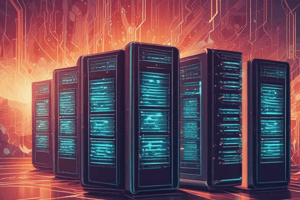Podcast
Questions and Answers
What is data processing?
What is data processing?
Manipulation of data into a more useful form.
Match the following categories of data processing with their descriptions:
Match the following categories of data processing with their descriptions:
Mechanical Data Processing = Combination of manual procedures and mechanical equipment Electronic Data Processing = Input, output, and storage devices interconnected to a computer Business Data Processing (BDP) = Establishing, retaining, and processing files of business data Scientific Data Processing (SDP) = Limited volume of input with many calculations
Which of the following is NOT an operation in data processing?
Which of the following is NOT an operation in data processing?
- Duplicating
- Recording
- Sorting
- Sleeping (correct)
Batch processing involves processing data in real-time.
Batch processing involves processing data in real-time.
What does real-time processing refer to?
What does real-time processing refer to?
Study Notes
Introduction to Data Processing
- Data processing involves manipulating data into a more useful form.
- College of Information System, Calayan Educational Foundation, Inc., offers an overview of data processing in Computer Fundamentals (COMP100).
Data Processing Cycle
- Basic Cycle: Input → Processing → Output
- Expanded Cycle: Origination → Input → Processing → Storage → Output → Distribution
Categories of Data Processing
- Mechanical Data Processing: Combines manual procedures with machines (e.g., typewriters, calculators).
- Electronic Data Processing: Involves interconnecting various input, output, and storage devices with computers.
Areas of Data Processing
- Business Data Processing (BDP): Focuses on establishing, retaining, and processing data files to produce useful information.
- Scientific Data Processing (SDP): Deals with limited input volumes and numerous logical or arithmetic calculations.
Data Processing Operations
- Recording: Transferring data onto forms/documents.
- Verifying: Checking recorded data for accuracy.
- Duplicating: Reproducing data on multiple documents.
- Classifying: Separating data into distinct categories.
- Sorting: Arranging data in a specific order.
- Calculating: Performing arithmetic operations on data.
- Summarizing and Reporting: Condensing data and presenting conclusions meaningfully.
- Merging: Combining multiple sorted data sets by a common key.
- Storing: Filing similar data for future reference.
- Retrieving: Accessing stored data when needed.
- Feedback: Comparing outputs to set goals.
Methods of Processing Data
- Batch Processing: Collects data/programs into groups for efficient serial processing.
- Online Processing: Equipment directly controlled by the computer’s CPU.
- Real-time Processing: Provides fast responses to data, impacting outcomes immediately.
- Distributed Processing: Links remote terminals to a central computer for inquiries and processing tasks.
Studying That Suits You
Use AI to generate personalized quizzes and flashcards to suit your learning preferences.
Related Documents
Description
Explore the fundamental concepts of data processing in this quiz designed for the Computer Fundamentals course at Calayan Educational Foundation, Inc. Understand the basic and expanded cycles of data processing, along with its categories and applications in business and science. Test your knowledge on the operations involved in transforming data into valuable information.




